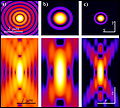Two-photon excitation microscopy
Two-photon excitation microscopy[edit]





Two-photon excitation microscopy is a fluorescence imaging technique that allows imaging of living tissue up to a very high depth. It is a special variant of fluorescence microscopy that uses two photons of lower energy to excite a fluorophore, instead of one photon of higher energy. This technique was first developed in the 1990s and has since become a powerful tool in biological research.
Principle[edit]
Two-photon excitation relies on the simultaneous absorption of two photons by a fluorophore. Each photon has approximately half the energy (and thus twice the wavelength) required for excitation. This process is nonlinear and occurs only at the focal point of the laser, which allows for precise spatial localization of the excitation. The use of longer wavelengths reduces scattering in biological tissues, enabling deeper penetration and less photodamage compared to single-photon excitation.
Applications[edit]
Two-photon microscopy is widely used in neuroscience, cell biology, and developmental biology. It is particularly useful for imaging thick specimens, such as brain slices or whole embryos, where traditional fluorescence microscopy would be limited by scattering and absorption. The technique allows researchers to observe dynamic processes in living tissues, such as neuronal activity, blood flow, and cellular interactions.
Advantages[edit]
The main advantages of two-photon excitation microscopy include reduced photobleaching and phototoxicity, as well as improved imaging depth. The localized excitation reduces out-of-focus fluorescence, enhancing image contrast and resolution. Additionally, the use of infrared light minimizes damage to living tissues, making it ideal for long-term imaging studies.
Limitations[edit]
Despite its advantages, two-photon microscopy has some limitations. The requirement for high-intensity pulsed lasers can be costly and complex to operate. The technique also has lower temporal resolution compared to some other imaging methods, which can be a limitation for certain dynamic studies.
Related pages[edit]
References[edit]
<references group="" responsive="1"></references>
Two-photon_excitation_microscopy[edit]
-
Two-photon_excitation_microscopy
-
Two-photon_excitation_microscopy
-
Two-photon_excitation_microscopy
-
Diagram of a two-photon excitation microscope
-
Two-photon microscopy of in vivo brain function
Ad. Transform your life with W8MD's Budget GLP-1 injections from $75


W8MD offers a medical weight loss program to lose weight in Philadelphia. Our physician-supervised medical weight loss provides:
- Weight loss injections in NYC (generic and brand names):
- Zepbound / Mounjaro, Wegovy / Ozempic, Saxenda
- Most insurances accepted or discounted self-pay rates. We will obtain insurance prior authorizations if needed.
- Generic GLP1 weight loss injections from $75 for the starting dose.
- Also offer prescription weight loss medications including Phentermine, Qsymia, Diethylpropion, Contrave etc.
NYC weight loss doctor appointmentsNYC weight loss doctor appointments
Start your NYC weight loss journey today at our NYC medical weight loss and Philadelphia medical weight loss clinics.
- Call 718-946-5500 to lose weight in NYC or for medical weight loss in Philadelphia 215-676-2334.
- Tags:NYC medical weight loss, Philadelphia lose weight Zepbound NYC, Budget GLP1 weight loss injections, Wegovy Philadelphia, Wegovy NYC, Philadelphia medical weight loss, Brookly weight loss and Wegovy NYC
|
WikiMD's Wellness Encyclopedia |
| Let Food Be Thy Medicine Medicine Thy Food - Hippocrates |
Medical Disclaimer: WikiMD is not a substitute for professional medical advice. The information on WikiMD is provided as an information resource only, may be incorrect, outdated or misleading, and is not to be used or relied on for any diagnostic or treatment purposes. Please consult your health care provider before making any healthcare decisions or for guidance about a specific medical condition. WikiMD expressly disclaims responsibility, and shall have no liability, for any damages, loss, injury, or liability whatsoever suffered as a result of your reliance on the information contained in this site. By visiting this site you agree to the foregoing terms and conditions, which may from time to time be changed or supplemented by WikiMD. If you do not agree to the foregoing terms and conditions, you should not enter or use this site. See full disclaimer.
Credits:Most images are courtesy of Wikimedia commons, and templates, categories Wikipedia, licensed under CC BY SA or similar.
Translate this page: - East Asian
中文,
日本,
한국어,
South Asian
हिन्दी,
தமிழ்,
తెలుగు,
Urdu,
ಕನ್ನಡ,
Southeast Asian
Indonesian,
Vietnamese,
Thai,
မြန်မာဘာသာ,
বাংলা
European
español,
Deutsch,
français,
Greek,
português do Brasil,
polski,
română,
русский,
Nederlands,
norsk,
svenska,
suomi,
Italian
Middle Eastern & African
عربى,
Turkish,
Persian,
Hebrew,
Afrikaans,
isiZulu,
Kiswahili,
Other
Bulgarian,
Hungarian,
Czech,
Swedish,
മലയാളം,
मराठी,
ਪੰਜਾਬੀ,
ગુજરાતી,
Portuguese,
Ukrainian




